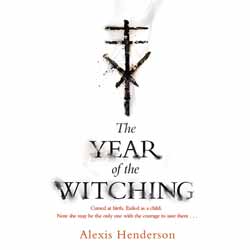|
Click here to return to the main site. Book Review
Immanuelle Moore had always known she was different, almost an outcast in her religious community. Her mother died at birth and with her the girl's history and place in the world. Headstrong, brave she sets off to discover the true nature of her past and power... The Year of the Witching (356 pages) is very much influenced by Alexis Henderson’s upbringing in a small religious group. The book explores the themes of sexual abuse, abuse of power and Immanuelle’s journey to find her own power. The setting for the book is cleverly placed nowhere and there is only a little world building for the reader to get a grasp of when or where this might be set. The town of Bethel is ringed by a wall, impassable without the Prophet’s permission. The Prophet, as the leader of the faith wields the ultimate authority. A town of thousands, it is abutted by the Darkwood, where legend has it that the last of the witches remain, hidden after the great purge. None in the town question the Prophet’s word and few would even conceive of leaving. The town is held under the sway of a quasi-religion which demands total obedience and engages in bloody rites. The town worships the Father all that is light in the world and apparently the only salvation for the town folk. The mother is held to be everything that is twisted and evil. It’s a subtle propaganda which works to keep the female population subservient, demeaning and questioning their sexuality as a force for good. Sexuality is also explored via Immanuelle’s menstruation. It is the onset of her menses which calls forth the curses which visit the town. No doubt this is to reflect the many historical instances of menstruation being held as something either dirty or something to fear. There is something in comparing a book to another well-known book, it gives a prospective reader some ball park into which to pitch their expectations. Whilst Margaret Atwood has been invoked, in connection to the story, she politicised women’s sexuality and reproduction, placing the control in the hands of a right wing patriarchy, the villain of this story is a simpler prospect, a power mad misogynist and the inability of people to stand up to evil. It is also true that through indoctrination and a lack of backbone, most, but not all of the males in the community are content to let this state of affairs stand, held in place by the power of their faiths doctrine. While the males may be complicit in the Prophet's behaviour, Henderson is careful not to place all of the males in the story beneath this shadow. Abram, her grandfather, is a decent man as is the Prophet's son, Ezra. Unlike Atwood’s world the abuse is neither systemic nor systematic, rather it is a perversion of one man who controls a system which allows his excesses to flourish. Gender politics aside, I thought that the author had really captured how power can corrupt and exemplify Edmund Burke’s adage, “The only thing necessary for the triumph of evil is for good men to do nothing.” 8 Charles Packer Buy this item online
|
|---|


